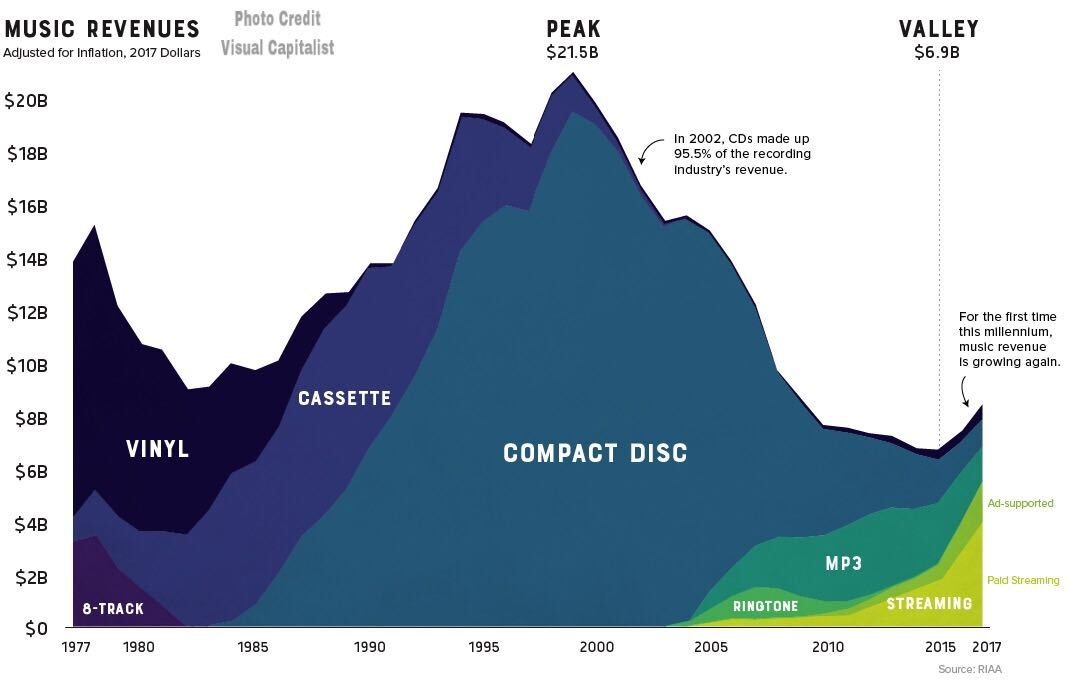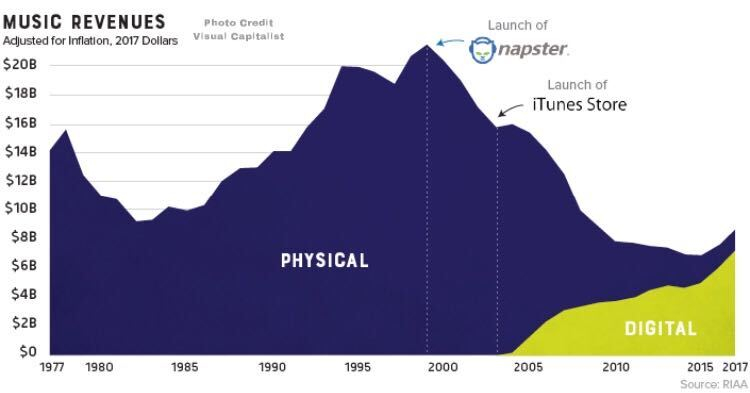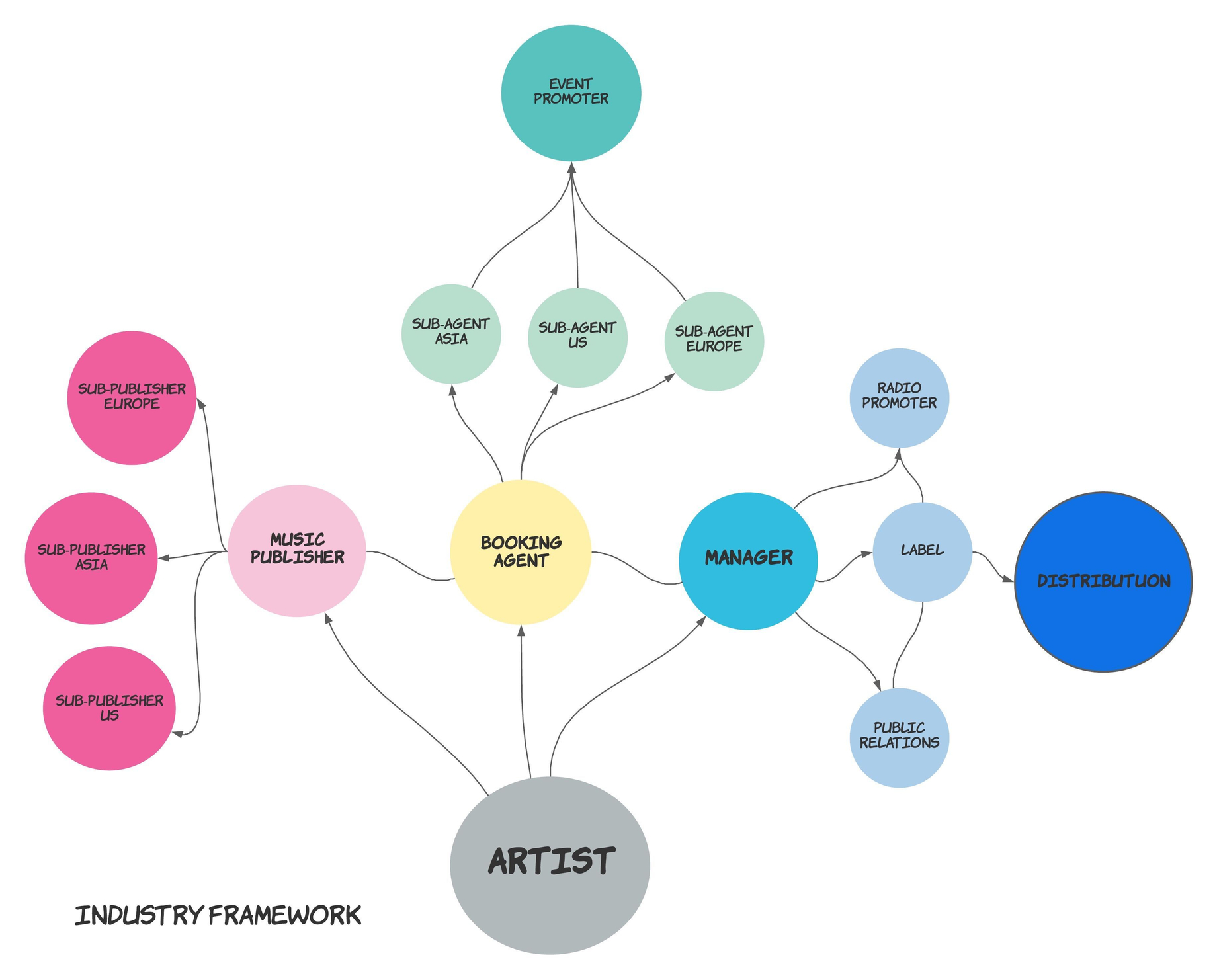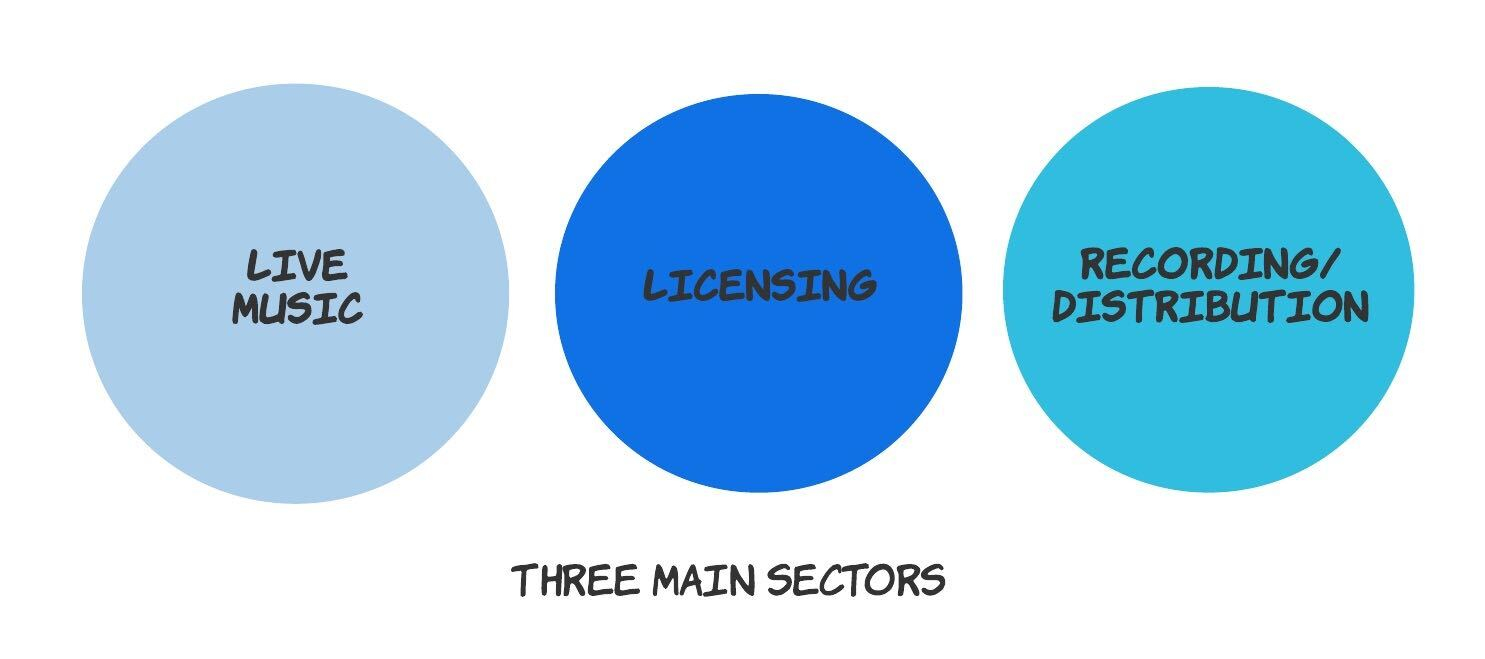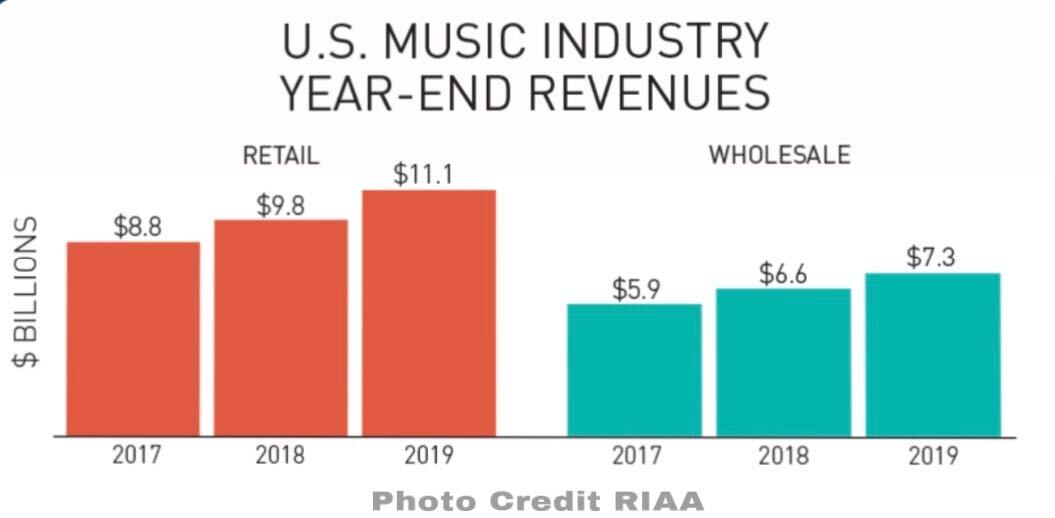Impact of Blockchain on the Music Industry in a Social Media Environment
I wonder if we'll look back at the past decade and say these times were a season of transition. I’m sure you feel it. You likely see it in everything you read. This industry and that industry are being completely transformed by new and exciting technologies. It’s quite amazing when you stop and take note. Forget the decisive environment- if only for a moment, and notice how we are not only transitioning to more technology-based hardware but we are creating environments that will benefit creators, businesses, and consumers.
A mutually beneficial music industry is the subject of our discussion today. Like every industry, it has seen sweeping changes. But also like every industry it has a lot to gain from blockchain. Adoption is ongoing all be it slow. But, as the saying goes slow and steady wins the race.
History Chimes
The music industry has had a lively history with several changes over the years. Not only has the method in which we listen and engage with music changed but the business side of the industry has had to grow and adapt to a new environment as well.
Handwritten sheet music was the first kind of foray into the distribution of music for a population. For the first time, the recreation of live music by professional composers and musicians was possible. But it wasn’t until the invention of the printing press that the music industry started to expand its reach.
Mass producing and distributing sheet music was a way for amateur musicians to learn and perform the music of the most popular composers. This new way of interacting with music led to increased fame of the original composers and a larger reach for their music. This lasted through the 19th Century until the advent of the phonograph.
In 1877 Thomas Edison invented the phonograph which gave people their first interactions with pre-recorded music. The novelty had people visiting ‘phonograph parlors’ to hear just a bit of the scratchy records made from shellac. The popularity of the phonograph grew with the advent of vinyl records in the 1930s and remained the main component of the music industry through the 1970s when cassette tapes became popular.
Cassette tapes significantly improved the sound quality so much that the immensely popular vinyl records now had a serious rival. But, just as cassettes impacted records so did the invention of Compact Discs in the 1980s and only ten years later did we see CDs take over.
The music industry experienced steady growth from sheet music to CDs with revenues continuing to climb. But as the saying goes, all things eventually come to an end. The number of CDs sold in the UK has plummeted from 132 million in 2008 to just 32 million ten years later. For the last 30 years the industry has been on a fast track of changing technology, attitudes, and behaviors that have left the music industry in constant transition.
The advent of the internet changed everything for everyone, including the music industry and it’s happened quickly. Some generations have never had to go to Best Buy on Tuesdays for the latest CD. That generation only knows music as a non-tangible thing they download from the internet.
The relationship between music and the internet started with MP3s and file sharing. It was mostly illegal and it came at a steep cost. Between 1999 and 2009 it is estimated that revenues for recorded music fell by 50%, worldwide. The industry was slow to react in the new fast-paced world that was emerging and they paid the price.
Napster, a peer-to-peer application that launched in June of 1999, allowed users to search and download MP3s right from their homes. At its peak, Napster pulled in 80 million registered users. It was particularly popular for sharing hard-to-find recordings, such as live sets, demos, and unreleased mixes.
In 2000 the Record Industry Association of America (RIAA) and various artists filed lawsuits against Napster for copyright infringement. The company lost and shut down in 2001. Napster may have been short-lived but its impact was far-reaching and affected the music industry forever.
Napster paved the way for other online sites to offer downloadable music and copyrighted files for free. Many artists and record labels tried to put a stop to the practice but the distributed nature made it difficult.
Some artists simply embraced the new distribution method. BitTorrent and DJ Shadow struck a partnership where DJ Shadow received revenue each time a user downloaded one of his new tracks effectively laying the groundwork for decentralized blockchain. DJ Shadow was a bit ahead of his time and the industry still had some transitioning. But, it was clear to see that record labels and artists who refuse to adapt to the changing times stood to lose out the most.
The internet was a force the music industry could not ignore. With rampant piracy unable to be reigned in, the industry had to face the inevitable and start a path to legal distribution of music over the internet.
By 2003, all five of the major record labels had signed on with Apple’s iTunes Store to provide a legal avenue for digital downloads. No doubt aided by Apple’s growing popularity in general, the iTunes Store had become the biggest music vendor in the USA by 2008 and by early 2010 in the world.
As Apple was becoming the biggest music vendor in the US, Spotify was providing access to unlimited and uninterrupted music for a monthly subscription fee. Alternatively, listeners could enjoy a limited amount of music with advertisements being played between every few songs. The service catapulted to 100 million subscribers by 2019.
Although these services haven’t met the sales figures like those seen previously with CDs the bleeding has stopped and the record industry is posting increases in revenue for the last three years with streaming taking up almost 90% of the market.
The Framework Was Complete
The music industry is more than how we listen to and distribute music and within this spidering framework, there are three distinct sectors each with its own focus but each closely related and part of the whole.
For years the largest sector is the recording industry which includes the recording and distribution of music to consumers. The recording industry generated the most revenues and starry-eyed artists were eager to sign a contract for the record label to pay for studio time and distribute their music.
The second sector is music licensing. Licensing was always a smaller, quieter part of the industry. It worked closely with other businesses to ensure licensing fees were fairly distributed among all parties involved.
Live music rounds out the three. Up to recently, sales generated from ticket sales typically took a back burner to those of the recording industry and often were operated at a loss. So much so that the record label would often pay to support the tour, which would enable bands to promote the album even though the actual tour was running with a loss.
This music industry structure, including the relationships between the three sectors, thrived from the mid-twentieth century and was deeply cemented when the Internet emerged to challenge the entire system.
While the internet stripped the recording industry of distribution control with online piracy, the licensing industry was seeing its revenues double as new avenues required new licensing models. To compensate, the recording industry and the licensing industry merged to make the recording, licensing, and distribution of music more streamlined and efficient.
The last twenty years have brought yet another shift as the dominant sector is now live music. Assuming the artist is in demand, live music provides a way for the artist to grow revenues by increasing the number of concerts and raising the ticket prices.
Now, no longer divided into three distinct sectors, the industry, in general, serves as an all-encompassing partner that is responsible for live concerts, merchandise, licensing, or distribution and promotion of recorded music to consumers. Flexibility to change business models has kept the industry aloft, even growing over the last three years.
(Block) Chain Reaction
Even with the flexibility to transition and revenues growing there are areas where improvements can be made to create an industry that operates in a cohesive manner that is beneficial to all parties.
Now that online streaming has established its roots in our culture it’s time to address the area where it falls short. Blockchain technology is the perfect method to streamline the relationship between artists, businesses, and fans. Let's take a look at a few areas where the industry can see the most benefits from blockchain.
Tokenized Ownership
Blockchain is inherently secure and transparent thus making it tailor-made to establish and prove ownership of content as well as the management of ownership rights.
Dragonchain tokenizes the licensing making it more flexible and customizable to be applied in both the streaming and physical environments. With micro-licensing, the licensing sector of the music industry can focus on micropayments for receiving and distribution.
Tokenized ownership can include the whole song or just a clip of a song. Time-based usage rights for use in advertisements or other media like movies can specify terms and to include royalty distribution and licensing perimeters.
Taking advantage of smart contracts will allow for greater transparency, defined royalty payouts, and tracking of every minute someone listens to a song. Take, for example, the song Come Together being used to advertise the Justice League movie. When the movie hits a streaming service a smart contract can be applied that stipulates the length of time the streaming service has usage rights to the song and since the song is tokenized every time it gets played and someone hears it, royalty can be applied to the artist.
Tracking the Creation Publishing and Use with Blockchain
From the creation, publishing, and printing of content to the distribution and use of said content, Dragonchain can prove every step of the process. Tracking not only the ownership of content but the creation of the content further establishes proof of ownership.
Blockchain allows for tracking on a micro-level to see that a listener may have only listened to a song for a minute. This is helpful in cases of streaming to analyze the popularity of the song.
Dragonchain can further provide provenance of every step of the creation process to be used in a scenario where disaster recovery is needed. As an example, imagine if an artist put their raw tracks, the mixed version, and the mixed output all on chain. And, if they had the mastered output and the published versions both on chain as well, they will then have provable ownership of each step in the process and each step on chain can be accessed for recovery.
As an additional benefit, licensing to each of those steps could be tokenized and monetized to support a market for music sampling. Music samples are often ill-defined with who made the sample and who owns the rights. Without knowing that information royalties can not be distributed at all much less fairly. Blockchain enables shared and decentralized data while tracking even the smallest amounts of content and how it is used to maintain ownership and ensure the proper distribution of royalties.
Blockchain’s role in content management can benefit the consumer as well. Currently, when consumers purchase a song or album on one streaming platform they are confined to that platform. By using blockchain, Dragonchain provides a very clear and secure way to offer proof that the content was bought by an individual and is still owned by that individual so it can be streamed on any platform.
Blockchain Enabled Payments
Traditional payment methods and channels can get a much needed update with blockchain technology.
Independent distribution channels allow for payments to be more easily broken down to the individual pieces that make up the larger framework. Using blockchain to set and follow standards established by the parties involved will allow for more transparency in what everyone is doing.
With micro-payments, artists can collaborate and set up consortiums with other streaming companies, and payments are more easily distributed. Blockchain-enabled payments can empower independent artists to profit from their content especially in a streaming environment dominated by big companies.
Time-based scarcity provides an opportunity to address refunds for content consumption when audiences are not happy with the purchase of the content. Refunds based on actual viewing or listening time can be pre-determined and dependent on time intervals. Artists and licensing contracts still see payments based on time of consumption so they get a little bit instead of losing the whole amount. This helps foster a better relationship with consumers because they know that hey if I don’t like it I can get a refund. The consumer is freer to take a chance.
Transparency Royalty Payout
Beyond royalty terms being defined at the contract level, Dragonchain makes it possible to selectively expose what royalty payments are between all parties. Blockchain naturally allows for transparency but with Dragonchain it doesn’t need to be public for the world to see. It can be determined by the contract who sees what parts of the contract.
Incentivized Content Surveillance
The digital environment created a booming economy for piracy and illegal downloads. To combat piracy Dragonchain has decentralized the surveillance of content. Dragonchain has established a process not yet attempted by other blockchains called Incentivized Content Surveillance which includes the process of watermarking and embedding bounties right into the content itself.
Blockchain Enabled Embargo System
With the embargo system orchestrating the timed release can be facilitated more efficiently and provide a mechanism to counter the violation of terms between parties. Blockchain and cron based smart contracts enable embargoed files to be on hand and ready to go but not released until a predetermined time or block. If a party were to breach the embargo it is easily tracked on chain providing proof of the breach and giving parties the legal recourse they need.
Watermarking with Blockchain
Dragonchain can place cryptographically based watermarks related to something on chain on the content. The content can then be traceable with the ability to selectively expose parts of the content. To access you would have to have access to the original business information that's on the blockchain to actually be able to decode it or to show proof that you own it.
Piracy Tracking Bounty
Currently, piracy tracking bots operate on places like YouTube or file-sharing services. It is common for bad actors to make adjustments to content to bypass the bots. Dragonchain can decentralize that surveillance by attaching a bounty inside of the content.
By attaching a certain amount of a cryptocurrency that is not tradeable on the open market to the content, the company can track the content through its supply chain. Once the token moves it can be tracked and marked with who was responsible for controlling the content at the different points in the chain making it easy to identify when and with whom the breach occurred.
Businesses could have stipulations that penalties will apply for breaches. The proof is visible on the explorer that the token attached to the content moved before when it was supposed to. If the content makes it through the supply chain to the rightful end user, then the token can be pulled as the content has now been delivered to the final location or the release date has arrived for the content to be heard.
This technology can be maintained for the life of the content to protect against further piracy. For example, let’s say someone located a pirated file. They could alert the business and/or return the file to the business for a reward.
When tracking pirated content it may be warranted to allow for anonymity since it doesn’t matter who is tracking the content it only matters where the content is and that it was returned. A hybrid approach is possible with Dragonchain.
Events System and Tokenization
It is always hard to know what kind of audience engagement any event will generate. Will it be sold out at 10 AM? Or will the entire mezzanine be empty? These blockchain-based measures drastically reduce or even will eliminate the risks associated with any event.
Blockchain-based scarcity is used to incentivize early ticket sales. Built into the customizable system, all parties have transparency into ticket prices. If a promoter wants to incentivize early ticket sales prices it can be written that prices will adjust through time so that the artist, promoters, and fans all know ahead of time for full transparency. Cheaper prices early will allow for events to sell out sooner and provide clarity for all parties.
This is very important when talking about right-sizing a venue for live music or even streamed events. If ticket sales are going well and the promoter wants to keep the event growing then they can switch venues.
Dragonchain uses Factor for identity-based ticketing to control the distribution of ticket sales and ensure that a single person does not buy too many tickets. The system can also prevent bots from purchasing tickets in excess to be sold at a later date for a higher price.
Scalping is a problem not only for promoters and artists but for fans as well. The transparent scarcity applied to ticket sales allows fans to know that they can get authentic tickets last minute if available, legitimately reducing the risk of counterfeit ticketing. Late ticket sales go to promoters and artists instead of the scalper.
Dragonchain’s event ticketing system drastically reduces counterfeit and provides chain of custody, transparency, security, risk mitigation for all parties including artists, promoters, and fans. Tie that system into a loyalty rewards program and now the doors are open for audience participation and engagement. Ready to let the fans decide where the next show will happen?
Audience Engagement and Loyalty
Blockchain-enabled loyalty and engagement go beyond the survey data set. Market research by way of the crowds can help define the approach.
When audiences are incentivized to weigh in on various pieces of content, marketers will gain powerful insights to know how they will react to a new-release, merchandise, or event. Better metrics and tracking will provide more control over the frequency of targeted marketing so marketers' efforts aren’t seen as spam.
Promoting allegiance by building and reaching a targeted audience is really important. Dragonchain provides the ability to curate loyalty in a way that attracts new people and rewards the most loyal fans. The social circles of the most loyal fans are incentivized to be rewarded in the same way so they too want to join the fan base.
Dragonchain based loyalty programs are customizable and provide the ability to track purchases, watches, appearances, and participation. Participation is not limited to the physical world. Online participation where the more people who are talking about a new release or event on social media the more interest is generated. Participants who engage are rewarded.
Further perks can be realized with VIP access. Also completely customizable to a small intimate gathering of the top 10 fans in the rewards program to a show of thousands. A show of thousands can be further incentivized to VIP backstage access for the top rewarded fans.
These perks can be applied to anything such as early releases, merchandise, or fan memorabilia. Providing a scarcity component to the rewards will generate competition amongst friends or other members in the loyalty program.
Leveled rewards are possible. In that, what is valuable as a reward to the audience when they are twenty may not be as valuable to them when they are forty. Dragonchain’s loyalty system grows with the audience providing a granular level of rewards for lasting engagement.
Non-Fungible Tokens (NFTs) are the perfect accompaniment to a fan loyalty program. NFTs are a cryptographic token that represents something unique, typically something digital. Live performances and festivals can be more immersive with NFTs. An artist supplying an NFT for concert attendance can create additional loyalty between fans and artists and facilitate the competition to get into the next show.
Dragonchain’s loyalty system fosters a time based social value of content. The fact that the more people talk about music and participate in events the more it will expand the content's reach and increase loyalty and engagement and therefore sales.
A Change is Gonna Come
The change from a physical format to a streaming one has just about taken over as the dominant way of engaging with music. With these changes, consumers now have:
- Immediate access
- Ability to purchase one song at a time
- Download exclusive tracks not on an album
- A library that goes deep and never closes
With the convenience afforded to consumers, the artists are not faring so well. Artists have criticized streaming sites for the low revenue-per-stream the streaming services generate. Spotify argues that 70% of their revenues go to rights-holders but the artist doesn’t necessarily hold the rights to their music. Streaming doesn’t provide a lot of transparency for artists in that they don’t know:
- The price the consumer pays
- The exact commissions the intermediaries and vendors take
- The exact amount of their commission
- How much money they’ll receive from a sale
- The number of sales achieved
The industry is still fragmented and is operating with pre-technology business methods. Transparency between the artists, song-writers, producers, music labels, the businesses, and streaming services is severely lacking and it is impossible to keep track of the songs created, the associated copyrights, and the revenues generated. Blockchain can remove the concentrated money flows from the few larger players and the streaming platforms then transparently distribute a fair share back to the artists. With royalties on chain, Dragonchain can track how the royalties are split up and distributed, proving everyone is receiving their entitled amount.
New Ways to Connect the Dots
Blockchain empowers artists with transparency and new revenue sources with peer-to-peer instant monetization. To facilitate the direct connection between artists and consumers, artists have forgone traditional promotions and turned to social media and working directly with streaming services.
Artists are tapping their strong knack for creativity with innovative campaigns. According to TechCrunch, concertgoers with the Nike SNKRS app were able to buy or reserve tour merchandise, including a pair of Kendrick Lamar’s latest collaborative pair of Nike trainers, while at a concert.
Social media is a pivotal part of the artists’ relationship with their fans. According to Econsultancy, a study conducted by MusicWatch shows that 90% of social media users take part in some form of artist-related activity on social media platforms. Also, two-thirds of social media say they discover new artists on social media and then head to online streaming services to listen.
These new direct relationships are really thriving in the independent music scene. A report by Wintel, showed streaming revenues from the indie sector alone saw an uplift of over 46% and increased its overall music market share to 39.9% in 2017.
Effects of (Corona) Virus
No matter one's thoughts on Covid the fact remains that its presence has impacted all facets of our lives. With strong revenues and a vibrant live music scene, the music industry was just starting to thrive in an internet-driven economy. Now with Covid’s arrival, the industry will once again see change.
Initially, it looked like the streaming industry was going to be hit hard with an 8% drop in music streams during mid-March 2020. Luckily, that was short-lived as a mid-year review from RIAA shows streaming is flourishing.
Live music, however, is another story. Fears of large-scale events not returning at all in 2020 have been realized and 2021 is not looking promising. With social distancing in place across the globe, concerts are still few and far between. And, although the show must go on, the ones that do are significantly smaller.
Some venues are opening their doors to smaller audiences who paid a premium for tickets. The challenge here and the question that venues and artists will likely debate is do you charge more per ticket for an intimate concert, likely shutting off access to the majority of one’s fan base, or do you find new ways to have the concert and revenue.
With the threat of an economic downturn on the horizon, the situation may arise where fans will have less disposable income. It may be difficult for fans to stay connected to their favorite artists necessitating the need to go beyond usual and customary avenues for engagement and start rewarding loyalty in a more tangible way. Live streaming the smaller shows will help maintain the connection.
One way artists may be able to maintain engagement with their fans during these times is through the virtual reality (VR) experience. VR isn’t new and has been around for a while. In 2017, The Gorillaz logged 3 million views for their VR music video of Saturn Barz, setting a YouTube VR record at the time.
We will eventually get back to live concerts. Right now they may be smaller and more intimate but concertgoers still hold out hope for their favorite summer festivals. Dragonchain can help facilitate the return to the stadium.
The Safety Dance
Through the use of Factor and SafePass, Dragonchain provides a way to allow fans into concerts without tracing and tracking them. The pass is HIPAA compliant and does not hold any health data. The concert venue would be able to confirm that a concertgoer is negative for Covid without exposing personal identifiable information.
Using a cryptographic key pair within the decentralized identity component (Factor), a person can show their records to whoever needs to see them, prove that they are legitimate, prove that the data is of quality and that there have been no changes to this data. They can further prove a test or event occurred on a particular date, who participated in the process i.e. the clinicians, and the source of the test.
While we wait for those privacy-focused applications to be widely adopted, let’s head over to Den.
Songs from The Den
Den.social is a blockchain-based social media platform built on Dragonchain’s hybrid blockchain platform, with diverse communities and free of traditional advertisements. The platform enables a self-governing and prediction-based marketplace of content creators, engagers, evaluators, and consumers without exclusion by algorithms. It has powerful anti-censorship capabilities, blockchain-based proof reports, and modern tokenized internal economies allowing for a more equal and fair distribution of value. Proof Reports of every action (Posts, votes, comments, edits, etc) are decentralized to Bitcoin, Ethereum Classic, and Ethereum.
Den provides a great environment for artists to monetize their craft by streaming live shows and interacting with their fans on a more intimate level. No blockchain knowledge is required.
Within Den are Lairs. Lairs are those individual communities of like-minded individuals who can engage with each other predicting how content is received and be rewarded for doing so. There are many diverse Lairs already with more on the way. But, the Lair that pertains to this post is the Music Lair.
Give Life Back to Music
Navy veteran and Dragonchain community member, Dave Johnson is doing what he can to give life back to music in a post-Covid world. HOOYAH. When Dave’s military service ended he came home looking to cruise back into civilian life, a transition that is truly difficult for a lot of our service members- but that’s a story for another time. He relied on the support of his brother and transitioned from “the service” to servicing his brother's band.
Dave learned a lot about the inner workings of the live music industry and specifically the festival circuit where he says, “The scene there is incredible. Some of the most powerful performances I've ever experienced were from these independent bands I'd never heard of before.” There’s something to be said for retaining the freedom to go your own path as an artist, perhaps one that gets lost when dealing with the big guys.
The self proclaimed computer nerd was bit by the Bitcoin bug while in the Navy and knew how the technology leveled the playing field. The doors could bust open for the independent artists who typically write their own songs and generally get paid less for doing so.
Once Dave found out about Den it all clicked and he had his next mission. The Music Lair. “My personal goal is to help artists get compensated using this new technology that is still very confusing to new people. There's money to be made there, and they're already doing the work to make it except they're not getting paid.” Dave found it frustrating that artists’ intellectual property was being captured, indexed, and sold by companies like Facebook, Instagram, and Twitter without any form of compensation.
Den provides the environment for Dave to carry out his mission. “The long-term vision is to have a place to genuinely interact with fans and other musicians in a way that benefits all parties involved. That's the dream, right? Make money doing what you're good at, and these people are very good at music.”
Heartwood Soundstage
Music venues around the country are searching for ways to survive in a post-Covid economy. Dave Melosh, Owner and General Manager of Heartwood Soundstage in Gainesville, Florida is right there with them. The live music venue opened in February of 2017 and was a vibrant spot for people to share in the love of music.
Heartwood saw rapid popularity and musicians such as Soja and Ghost Note, who you can check out in Den. Tom Petty Weekend, a music festival started at Heartwood after the death of Tom Petty. The festival is a yearly celebration of the life of the native Gainesville musician and had to be canceled this year due to Covid.
The Tom Petty Weekend wasn’t the only show to be canceled this past year. Heartwood is down 80% from the same time last year. Like most business owners, Mr. Melosh has had to adapt to the new environment. Heartwood is fortunate to have an outdoor space for shows, however social distancing takes a bite out of its capacity. While the open air space used for concerts is sitting idle Mr. Melosh started the weekly farmers market. The market serves the local Gainesville community and supports local farms, artists, and musicians.
Den and the Music Lair could help Mr. Melosh in this new economy. Heartwood is also a full-service recording studio and video production house. Unfortunately, with touring rates down, bands are not stopping in to use the studio after a show as they once did. With the equipment already in place, Heartwood is proving to be a great spot for live streaming local artists. Intrigued by the Den concept he saw how he could stream live performances directly from Heartwood Soundstage to the Music Lair. In doing so he can provide an additional revenue stream for the business and the artist, one that you won’t find with YouTube.
As for the future of the industry as a whole, Mr. Melosh says, "It will have to adapt to survive, times are tough for entertainers of all kinds." Though it’s early, Mr. Melosh already has performances lined up. Keep an ear out for premier musician, Juan Rollan who has played with legends Al Green, Miles Davis, and Ben Folds just to name a few, to join LPT, coming soon to the Music Lair.
As for Dave, his excitement is infectious. “I'm excited to experiment together with Heartwood Soundstage to bring world-class quality to the Music Lair, especially this early in Den development. I can't think of a better place to focus my energy right now, this is where it's at.”
Music is such an important part of our lives. It gets us revved up. It makes us laugh. It makes us cry. It calms us. It grabs at our memories and takes us back to moments in time where a simple song helped us endure. Whatever path the music industry takes from here one thing is for sure. The music will never die.
To hear more about how you can integrate blockchain into your musical environment contact us today.

